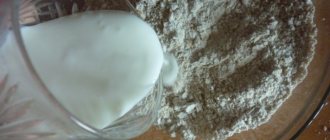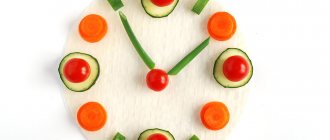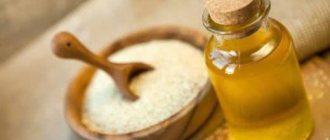Baklava
How to prepare the Baklava dish
- Grind walnuts and mix with powdered sugar and cinnamon.
- On a table sprinkled with flour, roll out the dough very thinly and cut into layers according to the size of the form in which the baklava will be baked.
- Place 2 layers of dough on top of each other in a greased pan, greasing each with butter. Apply the filling in a thin layer, cover with another layer and coat with the filling again.
- Continue layering the dough and filling until you run out of ingredients. The top layer should be made of dough. Grease it with yolk.
- Preheat the oven to 180°C. Cut the baklava into small diamonds and bake for 40-45 minutes. until a golden crust forms.
- Boil 0.3 cups of water, dissolve sugar in it and cook for 5 minutes.
- Add honey and cook, stirring, for another 8 minutes.
- Remove the baklava from the oven and let cool slightly.
- Cut into pieces along the marked cuts. Pour over the honey mixture and leave for 7-8 hours at room temperature until the baklava is well soaked.
- Puff pastry - 800 gr.
- Egg (yolk) - 1 pc.
- Butter - 100 gr.
- Honey - 250 gr.
- Sugar - 100 gr.
- Powdered sugar - 1 tbsp. l.
- Ground cinnamon - 1 tsp.
- Peeled walnuts - 2 tbsp.
Nutritional value of the “Baklava” dish (per 100 grams):
Calories:
448.1 kcal.
Carbohydrates:
39.2 gr.
Ingredients and calorie content of the Baklava recipe
(calorie content and nutritional value are calculated approximately, excluding boiling and frying)
| Product | Measure | Weight, g | Bel, gr | Fat, g | Angle, gr | Cal, kcal |
| cherry puff pastry yeast | 800 gr | 800 | 49.6 | 172 | 318.4 | 3024 |
| chicken egg | 1 PC | 47 | 5.97 | 5.12 | 0.33 | 73.79 |
| butter | 100 gr | 100 | 0.5 | 82.5 | 0.8 | 748 |
| honey | 250 gr | 250 | 2 | 203.75 | 772.5 | |
| granulated sugar | 100 gr | 100 | 99.7 | 398 | ||
| powdered sugar | 1 tbsp. | 20 | 19.96 | 74.8 | ||
| cinnamon | 1 tsp | 7 | 0.27 | 0.22 | 5.59 | 18.27 |
| Walnut | 2 tbsp | 400 | 60.8 | 260.8 | 28 | 2616 |
| Total | 1724 | 119.1 | 520.6 | 676.5 | 7725.4 | |
| 1 serving | 172 | 11.9 | 52.1 | 67.7 | 772.5 | |
| 100g | 100 | 6.9 | 30.2 | 39.2 | 448.1 |
This is a custom recipe, so there may be errors and typos. If you find them, please write them in the comments below the recipe and we will correct them.
Step-by-step recipes with photos from our website are in the “Recipes” section.
Secrets of making dessert
In order for baklava to be of high quality and truly tasty, it is necessary to adhere to specific principles.
1. In the process of preparing the dough for the oriental delicacy, you need to add a small amount of potato or corn starch to the flour. Thanks to this component, it will be much easier to roll out the dough, and the cakes will turn out thin, as stated in all recipes. In addition, the taste of such baklava will be incredibly delicate.
2. It is very desirable to give the cakes a diamond shape. It is recommended to do this before placing a layer of chopped nuts on the dough sheet. The cakes are cut with a sharp kitchen knife.
3. It is best to pour sugar syrup on top of the finished delicacy. To soak, leave the treat for 2-3 hours in a cool place.
4. Try to roll out the baklava dough as thin as you can. This is the most important condition for a tasty and truly authentic oriental delicacy.
Calorie content of honey baklava with nuts per 100 grams
The calorie content of baklava with nuts per 100 grams is quite high and amounts to 570 kcal. 100 g of delicacy contains:
- 10.2 g protein;
- 49.5 g fat;
- 24.5 g carbohydrates.
Thanks to the addition of nuts, the sweetness has a lot of additional beneficial properties, including:
- ensures the health of the skeletal system;
- stimulates the immune system and brain function;
- saturates the body with antioxidants, which reduce the likelihood of developing breast and prostate cancer.
Calorie content of Turkish baklava per 100 grams
The calorie content of Turkish baklava per 100 grams is 352 kcal. 100 g of sweets contain 3.55 g of protein, 21.72 g of fat, 35.3 g of carbohydrates.
The following ingredients are required for preparation:
- 0.25 kg filo dough;
- 0.15 kg butter;
- 0.4 kg brown sugar;
- 0.12 kg walnuts;
- 0.1 kg hazelnuts;
- 0.45 liters of water.
- the dough is laid out in layers;
- each layer of dough is coated with melted butter;
- sprinkle ground nuts on all layers except the last one;
- the last layer is thoroughly coated with butter;
- the dough is cut into squares and baked at 180° C for 45 – 55 minutes;
- The finished Turkish baklava is filled with syrup made from sugar and water and soaked for 4 - 5.5 hours.
Benefits of baklava
The following benefits of baklava are known:
- Baklava is full of fast carbohydrates, which almost instantly saturate the body with energy. It is for this reason that sweetness is indicated for restoring the body’s energy balance during intense physical and mental stress;
- in the east, baklava is in demand due to its ability to improve male potency;
- the presence of vitamins C, A, and group B allows baklava to be used to prevent heart and vascular diseases, strengthen the nervous system, and increase immunity;
- Some studies support the benefits of baklava for the prevention of anemia and asthma.
Baklava
Delicacy of November. Baklava
In past years, the delicacies of November were
foie gras , black cod , swallow's nests and curry , this year I wanted to nominate baklava - a confectionery product made from puff pastry with nuts in syrup, widespread among eastern peoples, and not only in Azerbaijani cuisine . which became our kitchen of the month.
You can say - just think, a delicacy! But we call delicacies not only very expensive and inaccessible, but also very tasty dishes. And yes, you can taste real baklava in the East.
There are a great many recipes for baklava, and even its shape can be different. For example, in different regions of Azerbaijan, baklava looks different: the classic baklava is in the shape of a rhombus, the famous Sheki one is square, and in the Gabala region they prepare a triangular baklava called “uchgulag”. People in Azerbaijan know a lot about desserts. And each region of the country has its own subtleties of preparing this dish. The most famous are Baku and Sheki baklava; Nakhichevan and Ganja differ from others. The differences are in the filling, filling and spice ratio. But absolutely all options are delicious - with walnuts, hazelnuts, and the addition of cinnamon or cardamom. These baked diamonds, with honey or ginger, with lemon or orange zest, sprinkled with saffron, are a must-have delicacy in all restaurants, coffee shops and pastry shops. And on Novruz, baklava is an integral part of the holiday.
Do you know that baklava almost caused an international scandal? Turkish and Greek Cypriots have historically fought over the right to call baklava their national dessert. After brochures were distributed in Cyprus on Europe Day claiming that baklava is an original Greek delicacy, a “confectionery scandal” erupted between the two countries. There were even protest rallies in Ankara, Izmir, Istanbul and other major Turkish cities. The Turks are confident that their ancestors invented baklava, and they do not intend to give up this priority. More than a hundred types of Turkish baklava amaze the imagination of gourmets: “wrapped turban”, “Sultan’s palace”, “lady’s belly”, “nightingale’s nest”. The Turks claim that the word “baklava” itself comes from a distorted Turkish exclamation “Bak lava!” - “Look, it’s sweet!”
It is quite possible that this is exactly the case, because according to historian Nuri Janly, the first mention of sweets dates back to the 15th century.
century: “The tradition of preparing thin dough for baklava came from the Assyrians. In the cookbook of the Ottoman Sultans' Museum in Topkapi Palace, there is a record from the time of Sultan Fatih, according to which the first "baklava" was prepared in the palace in August 1453. They say that the Sultan liked the cook’s invention so much that he ordered his recipe to be immortalized. Since then, baklava has been prepared at every holiday.”
The famous sweet shop in Istanbul, Golluolu, has been selling baklava for over two hundred years. Regular customers here are footballers from the famous capital club Fenerbahce, who have been eating baklava for many years before every important match. The advertising poster in the center of the hall depicts the most talented football player in Turkey, the owner of the so-called “Golden Boot”, the famous Tancu Collak, with baklava in his hands, which he calls “Turkish Viagra”. And all because there is a legend that “a mixture of nuts, honey and transparent dough gives a feeling of sexual flight and helps increase potency in men.” I won’t disappoint anyone, I’ll just say that 100 grams of baklava may give you a feeling of flight and lightness, but more, on a regular basis, will lead to excess weight and insulin resistance. Try stopping at 100 grams! This is confirmed by Turkish nutritionist Gündüza Tavukcu, who sees one of the main reasons for the excessive forms of many Turkish women in the age-old custom of eating baklava every day, even for breakfast. “The Mediterranean type of woman is, first of all, steep hips and lush buttocks, which, at the slightest non-compliance with the diet, sharply increase in size. However, our women eat baklava even in the morning. After eating the high-calorie delicacy for a long time, beauties go to the doctors, pay thousands of dollars to remove excess fat, and then start eating baklava again!”
Baklava is a multi-layered dessert made from paper-thin sheets of dough that are coated with butter and layered in a rectangular baking dish or rolled into cylinders. Ground and finely chopped walnuts or pistachios are laid between layers of dough, which are previously baked and soaked in a solution of sugar and lemon juice with spices and rose water. The recipe for making baklava contains many secrets. For example, you need to use only cornstarch, otherwise the dough will stick together.
Do you want to prepare a delicacy with your own hands? Let's try!
Azerbaijani baklava
Ingredients:
For the dough: - 1/2 cup of milk - 1 egg, - teaspoon of yeast, - pinch of salt, 2 tablespoons of melted butter.. for filling: - one and a half cups of peeled walnuts, - 1/2 cup of powdered sugar, - 2 tsp. teaspoons vanilla sugar, - egg yolk, - 1/2 cup honey
- cardamom, cloves, saffron and cinnamon to taste
- For the dough: heat the milk, dissolve the yeast in it, add a pinch of salt, melted butter and an egg. Mix thoroughly, gradually adding flour. Leave for 1.5 hours.
- For the filling: sort out the nuts and fry in a dry frying pan for 3-5 minutes, the main thing is not to burn them. Grind the nuts in a blender and mix with powdered sugar, spices and vanilla sugar. Mix everything well until smooth.
- Knead the settled dough a little and cut into 7 parts, roll each of them into a thin layer, place one at a time on a baking sheet greased with butter. Brush each layer with melted butter and cover well (amply) with filling. Brush the top layer with beaten yolk and cut into large diamonds. Place a nut in the middle of each diamond.
- Preheat the oven to 190 degrees and leave the baklava for 25 minutes. At this time, take honey and melt it in a saucepan over high heat.
- After 25 minutes, take out the baklava, pour in honey and put it back in the oven for 15 minutes.
Baklava with nuts and pistachios
Ingredients:
For the syrup: 450 g sugar 160 ml honey 2 cinnamon sticks 2 tablespoons freshly squeezed lemon juice
For baklava: 300-330 g walnuts 400 g raw unsalted pistachios 170 g sugar 2 teaspoons lemon zest, finely grated 1.5 teaspoons ground cinnamon 50 g dried apple rings, chopped 20 pieces of fresh or frozen phyllo dough, size 42 .5 x 30 cm 340 g butter, melt
1. Syrup: Combine all ingredients and 240 ml of water in a saucepan. Bring to a boil over medium-high heat, stirring until sugar dissolves. Reduce heat to medium and simmer for about 15 minutes until 480ml syrup remains. Pour into a bowl and let cool completely. You can prepare the syrup a day before preparing the baklava. In this case, cover the bowl with cling film and place in the refrigerator.
2. Baklava: Preheat the oven to 175 degrees with one rack at the top and a second rack at the bottom of the oven.
3. Place walnuts in a large baking dish. Place pistachios in a separate baking dish. Place in the oven for 5 minutes. Cool. Transfer to a food processor. Add sugar, lemon zest and ground cinnamon. Grind until the nut pieces are small. Transfer to a large bowl. Add dried apples.
4. Place all pieces of phyllo dough on the work surface. Cover with plastic wrap and a damp kitchen towel. Grease a 32.5 x 22.5 x 5 cm metal baking pan with melted butter. Place one sheet of dough in the pan, allowing half of the dough to hang over the long side of the pan. Brush the dough in the pan with melted butter. Cover with the other half of the dough to form 2 layers approximately 1 cm thick and measuring 30 x 20 cm. Brush with melted butter. Repeat the same procedure with 4 more pieces of dough. There should be 10 layers in total. Spread 1/3 of the nut mass on top, leaving a 1 cm edge. Continue laying layers of dough on top 2 more times, 5 pieces of dough each. Add 1/3 of the nut mass each time. Cover with the remaining 5 pieces of dough (10 layers).
5. Using a sharp knife, cut the baklava (do not cut into separate pieces) into 16 rectangles. Bake for about 45 minutes until the dough is lightly browned. Pour syrup over hot baklava. Cool to room temperature. Can be prepared a day ahead of serving. If so, cover and store at room temperature. Cut the rectangles in half to make 32 squares.
Cooking stages
First you need to dissolve the yeast in warm milk and add a little salt. Then add the beaten eggs and flour, adding oil while stirring. Next, you should put the dough in a pan and wrap it with a warm blanket or place it in a basin with preheated water, but not higher than +30 ° C. In winter, you can simply place it closer to the radiators, making sure that the dough does not cool down or overheat.
When it rises, you need to divide it into 45 even parts and roll it into very thin cakes, grease them with butter. Laying the cakes on a baking sheet, place them on top of each other, adding to every second, except the first and last, the prepared filling of ground nuts, sugar, honey and cardamom. Next, carefully cut the resulting stack into oblong cubes and brush with egg yolk.
The average baking time is half an hour, the temperature is 180 °C. At the end, you can pour butter over the baklava.
A delicious oriental dessert is ready!
Is it possible to prepare baklava at home and how to do it? A question that worries all those with a sweet tooth who have at least once tried this oriental delicacy. Today I will share with you a step-by-step recipe for homemade honey baklava: many layers of dough, nut filling and fragrant syrup - it just melts in your mouth, making you forget about everything in the world...
As you know, there are a huge number of baklava recipes and every housewife will have the right one. Personally, I cook homemade baklava extremely rarely (once every few years) and all because I cannot limit myself and my family from temptation and sweet temptation. On the other hand, natural honey, fresh walnuts and good quality butter are quite expensive products, so baklava can hardly be called an affordable dessert.
Before writing a detailed recipe for a dish that is popular in many countries, I always read a lot about it. However, unfortunately, today it is hardly possible to find out anything accurately and for sure. What I mean is that some copywriters steal articles from other sites, remaking them for search engines, others copy them from them, without bothering to search for the correct information... A vicious circle.
What are these lyrics for? The thing is that I really wanted to understand the names and features of different types of baklava. Baku (Azerbaijani), Armenian, Turkish, Crimean... Eyes run wild, but the exact and significant differences are not described in the recipes.
It is clear that Crimean baklava is deep-fried dough, generously covered with syrup and sprinkled with nuts, and all other types are a multi-layered dessert, which I wrote about above. The difference, in my opinion, is in the dough, which serves as the basis of baklava (phyllo, puff pastry, yeast) and the shape of the confectionery. A variety of nuts are used for the filling - for example, walnuts or pistachios (for us this is a luxury). The syrup can be honey, honey-sugar, with lemon juice and rose water.
In any case, today we are preparing an incredibly tasty, very, very filling and aromatic dessert. Unlike the cloyingly sweet versions of the original baklava, I deliberately reduced the amount of sugar in the nut filling. However, the calorie content of baklava is off the charts, which should be remembered when your hand reaches for the next piece...
Recipe for Baku baklava
- We invite all lovers of Caucasian sweets to the table. Today we will prepare Baku baklava . This dish belongs to Azerbaijani cuisine. Baklava is prepared for big holidays and a lot, and it is also often prepared by grandmothers and mothers in order to please their beloved grandchildren and children with sweet pastries. When properly prepared, baklava turns out surprisingly tasty, and the spices used remind us of the Eastern origins of the dish. In the Caucasus, baklava is served in cafes as a sweet dessert, which is ordered to the table not only by children, but also by all lovers of sweets. It is prepared from puff pastry, and it is believed that the thinner the dough, the tastier the dish. There are many variations in the preparation of baklava, since each people in the Caucasus prepares baklava in its own way, adding certain products, using different types of flour. The world of baklava recipes is large and diverse, and therefore we move directly to its preparation
To prepare fabulous Baku baklava , only the highest grade flour is used. Before cooking, it is advisable to sift the flour through a sieve. In a deep and wide saucepan, dilute the yeast with warm water, add sifted flour, sour cream, and beat in the egg. A little ghee won't hurt. Add salt and mix everything thoroughly. If it’s uncomfortable in the pan, you can knead the dough on the table. But the main thing is not where to interfere, but how to interfere. The dough must be very well kneaded
Divide the finished dough into several pieces, and roll out each piece to a thickness of 0.5 mm. As we said above, the thinner the dough, the better the baklava will be. Grease a baking sheet with oil and place the first layer of dough on it. Spread the hazelnut and sugar filling onto the dough in an even layer. To do this, remove the shells from the nuts and grind them into small pieces, you can pass them through a meat grinder, and then mix with sugar. The filling for baklava is ready. Cover the filling with the next layer of dough, grease the dough with oil and spread the filling again. We continue this procedure until the prepared products run out. The main thing is that the top layer is dough. After this, cut the baklava into diamonds measuring 10x4 cm
Before putting the baklava in the oven, brush the top layer with yolk mixed with saffron infusion, and put half a nut in the middle of each diamond. Place the prepared baklava into the oven. Baklava is baked in the oven at 200 degrees for 35 - 40 minutes. Then the baklava is removed from the oven, brushed with syrup or honey on top and put back in the oven for another 5 minutes.
Baklava is usually served cold or warm.
with Baku baklava : milk, tea, coffee, juice, compote. The choice of drink depends only on personal preferences. In our recipe we used hazelnuts, but you can experiment and make baklava with walnuts or almonds .
Get a completely different taste and a lot of vivid impressions from the prepared dish. Bon appetit!
Real advice! Be the first to know!
Product Information
Baklava is a confectionery product made from puff pastry. Its components also include nuts (hazelnuts, pistachios, almonds, walnuts, etc.) and sherbet. The sweet filling is alternated with thin sheets spread with honey, and then filled with sherbet. Sometimes sugar syrup, pieces of apples, and often spices and seasonings (cardamom, cinnamon, cloves), and lemon juice are added to baklava. The product is baked in rectangular shapes. As a result, this combination of edible components leaves few people indifferent.
This product has other names. In countries where it is directly produced, the terms “baklava” or “baklava” are used to refer to the sweet delicacy. Scientists discovered the first mention of this oriental sweet in a cookbook that belonged to the court cook of Topkapi Castle. According to the recipes indicated in it, dishes were prepared for Sultan Fatih himself, whose great-great-grandson was Sultan Suleiman of Lenten. The book dates back to the 15th century. However, baklava would never have been born if not for the Assyrians. They became the authors of the thinnest puff pastry - the basis of an oriental delicacy.
There is another legend about the creation of baklava. In this legend, the Greeks appear as the authors of the sweet delicacy. According to ancient legend, the Hellenes brought baklava from Asia Minor, where they learned to prepare the product back in the 8th century BC. As a result, the residents of Athens liked the delicacy so much that they made a very successful attempt to improve the dough used to prepare the nutty delicacy.
Baklava is produced in almost all eastern countries. This includes Turkey, Azerbaijan, Arab countries, and Armenia. It is prepared by Crimean Tatars and Ossetians. And for everyone, without exception, the delicacy turns out to be divinely tasty, although there may be some differences in the ingredients. In Russia, you can try baklava in any oriental cafe or restaurant.






